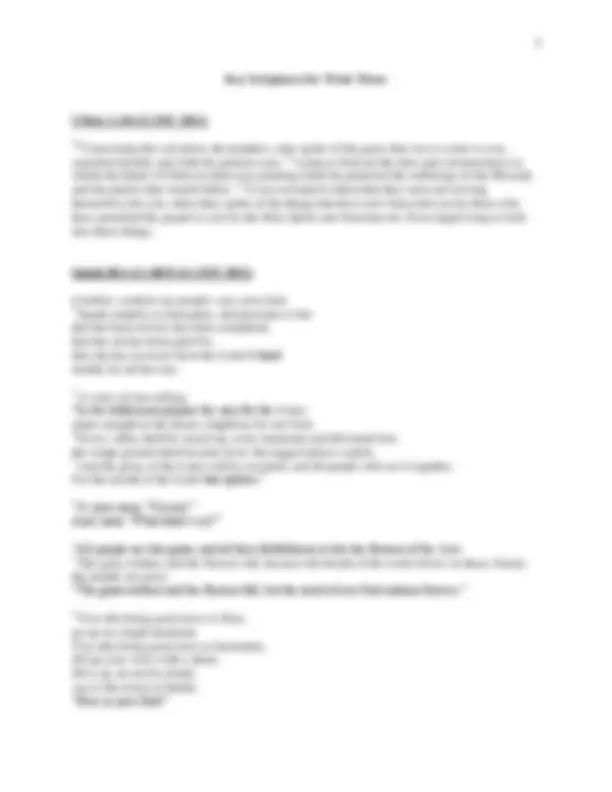




Study with the several resources on Docsity

Earn points by helping other students or get them with a premium plan


Prepare for your exams
Study with the several resources on Docsity

Earn points to download
Earn points by helping other students or get them with a premium plan
Community
Ask the community for help and clear up your study doubts
Discover the best universities in your country according to Docsity users
Free resources
Download our free guides on studying techniques, anxiety management strategies, and thesis advice from Docsity tutors
Focus for Week Three. In Isaiah 40, the prophet celebrates the present and future rule of God. His rule is that of.
Typology: Slides
1 / 4

This page cannot be seen from the preview
Don't miss anything!



Anticipated Present Realities of Jesus November 18 – December 30 2012, Week Three of Seven “Jesus, the Sovereign Shepherd-Lord” Isaiah 40:1-11(40:9-11), Dec 2 2012
Focus for Week Three In Isaiah 40, the prophet celebrates the present and future rule of God. His rule is that of “the sovereign Lord” (40:10); his rule is like a “shepherd that tends his flock” (40:11). No wonder that people are told to say, “Here is your God!” (40:9). What a contrast this God is to the gods the people followed and to the nations that God’s people feared more than they feared God. And then to think that Jesus perfectly displayed and NOW displays this “sovereign shepherd-rule” of God is absolutely wonderful. Truly, in Jesus, we see, “HERE IS OUR GOD!”
Summary of “Time of Reflection” and Message
The “Spirit of Christ” in the prophets (see I Peter 1:11) spoke of anticipated realities of Christ that would be fulfilled in his first coming, his present rule, and fully in his second coming Some struggle with what God is like; many struggle to see how God is present. This was true in the setting where Isaiah speaks. With this in mind, what comfort Isaiah offers when he anticipates that Jesus is one about whom people can now say, “Here is your God.” Jesus himself said, “Anyone who has seen me has seen the Father” (John 14:9). Wow, what a present reality of Jesus we can experience now.
2. Summary of Message
Introduction: Looking at the prophecies that anticipate present realities of Jesus is like looking at a clear night sky full of stars; while we are have difficulty trying to focus on one star in the messages, this is difficult because each star is surrounded by so many other prophecies that point to Jesus. It is hard to separate out one star from the rest; the stars together point to realities about Jesus that are truly holy and awesome and worthy of our praise.
From Isaiah 40:9-11, what do we see of Jesus then (i.e. first coming), now (i.e. present rule), and “even more then” (i.e. second coming)? a. Our God is here; we see his glory, not hidden, “all together” (see Isaiah 40:5, which describes his presence). b. The Sovereign (i.e. absolute) Lord; all authority in heaven and on earth belongs to him such that NOTHING is beyond his rule. c. He came, is present, and is coming again with power. d. He rules with a mighty arm, which points to his authority over kings and nations.
e. His just reward and recompense (i.e. payment) is with him; what greater reward is there that he who knows our sins completely values our life enough to die for our sins and bring us to welcome him as our Lord. f. He treats us like a loving shepherd, tending his flock, gathering lambs in his arms, carrying those new to life in him close to his heart, leading gently.
From Isaiah 40:9-11, what does this all mean for us? a. We no longer have to be afraid; Jesus often said, “Fear not; I am with you.” b. We have someone who hears our voice and desires that we lift our voice to him. c. We have GOOD NEWS to share with ourselves, each other, and those to whom he sends us (see Isaiah 6:1-8).
For Further Study
(^1) Seven reasons from NIV 2011 Study Bible why Isaiah may have written all of Isaiah 1-66. 1) “The Holy One of
Israel” is used to speak of God 12x in 1-39 and 14x in 40-66; it is only used 6x in the rest of the Old Testament. 2) Striking verbal parallels between two halves (e.g. 1:2 & 66:24; 1:5-6 & 53:4-5; 5:27 & 40:30; 11:6-9 & 65:25). 3) At least 25 Hebrew words found in Isaiah that occur in no other prophetic writing. 4) Isaiah’s use of fire as a figure of punishment (e.g. 1:31, 10:17, 33:11-14, 66:24). 5) His references to the “holy mountain” of Jerusalem. 6) The structure that includes a historical interlude (i.e. Isaiah 36-40) that concludes 1-35 and introduces 40-66. 7) Several NT verses that refer to the prophet Isaiah in connection with all parts of the book.
(^10) See, the Sovereign LORD comes with power,
and he rules with a mighty arm. See, his reward is with him, and his recompense accompanies him. (^11) He tends his flock like a shepherd:
He gathers the lambs in his arms and carries them close to his heart; he gently leads those that have young.